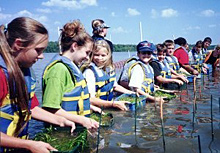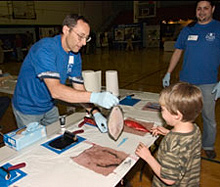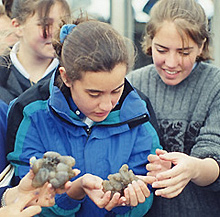Celebrating a Continued Focus on the Oceans, Coasts, and Skies
The materials within this section have been selected to help teachers, students, and parents learn about our ocean, coasts, and skies. The information is organized into three sections to help you Explore, Understand, and Protect our marine and atmospheric environments. Within each section, you'll find links to Web sites and downloadable lesson plans and educational materials. To help you find the most appropriate materials, we've also included target audiences for all links. Enjoy your exploration!
Explore the Oceans, Coasts, and Skies
Informational Web Sites
The Discover Center, hosted by NOAA’s National Ocean Service, provides innovative products that enlighten students and teachers about oceans, coasts, and charting and navigation. The Center contains Discovery Kits to teach science principles, Discovery Stories to use as research case studies, and the Discovery Classroom to provide inquiry-based formal lesson plans. Target: Educators and students (grades 9-12)

At the Smithsonian Folklife Festival, NOAA staff teach children how chemicals and pollutants can enter drainage paths that flow into the Chesapeake Bay.
Ever wonder how satellites stay in orbit? This site gives an overview of both human-made and natural satellites and their orbits and provides in-depth information about the different functions satellites serve in communications, scientific, and environmental research. For educators, there are classroom and lab exercises, student readings, activities, interactions, and review sections. Target: Teachers and students (grades 9-12)
Environmental Visualization Program Education Collection
See what Hurricane Katrina and other major storms looked like from space! This site demonstrates some of the amazing ways satellite imagery is used in scientific research, resource management, and policy decisions. You’ll find animations and images of tsunamis, sea temperature change, and even the flight track of a hurricane hunter airplane. Target: Educators and students (grades 9-12)
Calling all game lovers! You won’t want to miss this interactive weather adventure game, which allows you to play games involving weather stories. Test your knowledge on the joke machine. There is so much to explore! Target: Educators, parents, and students (grades 6-12)
Underwater Exploration Timeline
Take a tour of diving history with the illustrated Underwater Exploration Timeline! Learn about significant discoveries and the people involved with them from prehistory to the future. Target: Educators, parents, and students (grades 6-12)
Lesson Plans & Educational Products

School children visit a NOAA hurricane hunter aircraft while on a stop in Mobile, Alabama.
Educators will find an amazing source of lesson plans, curricula, education modules, and other teaching tools on this comprehensive site about ocean exploration. Topics range from deep sea corals to robotics, are based on expeditions, and are divided by grade range (5-6, 7-8, and 9-12). Information on professional development is also offered. Target: Educators and students (grades 5-12)
Remote Sensing and Coral Reefs
This comprehensive curriculum includes lesson plans and activities that provide students with an understanding of how remote sensing and satellites are used to monitor the environment around coral reefs. The information gathered in these monitoring programs is invaluable to the agencies responsible for managing and protecting this unique ecosystem. Target: Teachers (grades 4-8)
Geodesy is the science of measuring and monitoring the size and shape of the Earth and the location of points on its surface. NOAA and its predeccesor organizations have been involved in the geodesy since President Thomas Jefferson created the the Coast Survey 200 years ago. Today, NOAA’s National Geodetic Survey uses geodesy for navigation, communication systems, and mapping. This lesson explains geodesy and why it is important to us today. Target: Teachers and students (grades 9-12)
See That Sound (Hydrographic Surveying)
Hydrography is the science of measuring and describing the physical features of bodies of water and adjacent land areas that are periodically underwater (such as areas that are covered and uncovered by rising and falling tides). The most common use of hydrographic data is as an aid to safe navigation. This educational activity explains the concept and major components of sonar systems used to collect hydrographic data. Students compare and contrast multibeam and sidescan sonar systems and design a relatively low-cost sidescan sonar system that could be built by an amateur ocean explorer. Target: Teachers and students (grades 9-12; 12 pages, PDF)
Understand the Oceans, Coasts, and Skies
Informational Web Sites

Kids learn about the equipment that allows SCUBA divers to breathe underwater.
Visit an estuary without leaving the classroom! This Web site provides access to information about estuaries as well as EstuaryLive, an interactive fieldtrip program for classrooms, EstuaryLive can be viewed by anyone over the Internet. The bays, sounds, lagoons, and sloughs that make up estuaries are inspirational sites enjoyed by many. They are important to the U.S. economy and provide protection from floods and storms. Target: All ages and educators (requires RealPlayer)
OceansLive is a Web portal that puts visitors in touch with resources covering all aspects of the ocean via the Web. The site includes connections to live underwater events, a live Webcam of Monterey Bay, information on a variety of ocean topics, photos, videos, lesson plans tied to national standards, and educational links for all ages. Target: Educators, students (all levels), and adults
Is your family prepared in case of a thunderstorm? What about a hurricane or earthquake? This quiz will tell you if you are prepared, and help you develop an emergency plan so you can be storm safe! Target: Children and families
Lesson Plans & Educational Resources
Are you a teacher interested in doing science at sea? Then the NOAA Teacher at Sea Program is the place for you to look. Since its inception in 1990, the program has enabled nearly 500 teachers to gain first-hand experience of science and life at sea. By participating in this program, it becomes possible for teachers to enrich their classroom curricula with a depth of understanding made possible by living and working side-by-side, day and night, with those who contribute to the world's body of oceanic and atmospheric scientific knowledge. If you’re ready for a life-enriching adventure that will benefit you, your students, and your community, you could be our next NOAA Teacher at Sea! Target: Educators
NOAA Teacher at Sea Children's Books
In 2005, The NOAA Teacher at Sea program unveiled its first children's book with the aim to make NOAA science understandable and exciting for students across the country. The most recent book, "Teacher at Sea: Mrs. Armwood's Hydrographic Adventure on the NOAA Ship FAIRWEATHER" (pdf, 5946kb) focuses on hydrographic research. Target: Students (middle school)

Children learn how to plant wetland grasses at NOAA Restoration Day.
In conjunction with the University of South Alabama, these lesson plans and student activity books have been developed for middle school students and Educators. Teaching materials cover subjects ranging from El Niño to fisheries. Target: Educators and students (grades 6-12)
Ocean Explorer – Ocean Challenge Puzzle
Test your ocean literacy with the Ocean Challenge Puzzle! With each correct answer, you’ll reveal another tile of the puzzle. Collaborate with other users to reveal the full picture. Target: Educators, students (grades 9-12), and adults
Ocean Explorer – Multimedia Learning Objects
These visually stunning multimedia lessons will engage any audience. The lessons include a variety of topics, ranging from mid-ocean ridges to water cycles to ocean pollution. Target: Students and educators (all levels)
The Bridge contains lesson plans and resources on a variety of ocean science topics, research and data connections, professional development for educators, information to guide students (careers, summer programs, etc.), a resource center, and connections to other educators. Target: Educators and students
Marinecareers.net is a comprehensive resource for students seeking information about careers in marine biology, oceanography, ocean engineering, and related marine fields. Students learn about the various marine fields and professionals current working in those areas, about occupation salaries, and about resources to help them choose a college. Target: Students (grades 6-12)

Students study a water sample taken from the Monterey Bay National Marine Sanctuary.
Fisheries Learning on the Web (FLOW) is a comprehensive curriculum about the Great Lakes ecosystem. Each lesson on the site is aligned with national and state curriculum standards for science and social studies and features a hands-on classroom activity. Target: Educators (grades 4-8)
These printable activity sheets and science projects cover a wide range of subjects, from marine mammals to crabs, to gets kids excited about the marine environment. Target: Educators and students (grades 3-5)
NOAA National Marine Sanctuaries Program: Curriculum, Lesson Plans, and Activities
This Web site includes lessons plans and activities for download on a range of topics, from using coral cores to study changes in climate to using geographic information systems to help students learn about the oceans. Target: Educators
Are you an educator, emergency manager, or simply interested in learning about weather and weather safety? Get the information you need to remain safe during severe weather events. This comprehensive site will keep you informed and up to date.
Target: Parents, educators, and students (grades 9-12)

Restoration projects provide unique opportunities to educate the community about the benefits of coastal habitat restoration and creates an opportunity for hands-on involvement.
National Severe Storms Laboratory
Don’t know where to start in learning about severe weather? This Web site provides basic information for educators, parents, and students. Coloring books are available for elementary school age children to print and use for weather education in the classroom or at home. A comprehensive list of Teacher Resources can help with lesson plans. The site includes a history of weather maps and symbols. Target: Educators and students (grades K-12)
Teacher’s Resource for Ocean Science Education
Help promote ocean literacy! The Centers for Ocean Sciences Education Excellence (COSEE) is dedicated to creating environments in which collaborations among ocean scientists and K-12 educators flourish. Educators can participate in professional development programs and join scientists as they study the Ocean and Great Lakes, and bring the materials, activities and experiences back to your classroom. Target: Educators
NOAA National Estuarine Research Reserve System: Curricula, Lesson Plans, and Activities
This is a collection of curricula, lesson plans, activities, and presentations that have been developed by some of the National Estuarine Research Reserves and which can help introduce students to specific estuarine topics and environments. Target: Educators and students (grades K-12)
Fun for You
The Woods Hole Science Aquarium’s FAQ
How many eyes does a horseshoe crab have? Why do fish have whiskers? How long can seals and turtles hold their breath? Learn the answers to these and many other cool questions at the Woods Hole Science Aquarium. Target: All ages
Meet Owlie Skywarn! He has much to teach you about the hazards of severe weather, including tornadoes, lightning, hurricanes, flash floods, and winter storms! Target:: Students (grades 3-6)
This family-friendly site turns weather events into fun learning opportunities! Download coloring and activity books. Learn more about hurricanes, winter storms, tornadoes, thunderstorms, lightening, floods, safety tips, and other general weather information through games and fun activities the whole family can do together! Target: Children and families
Protect the Oceans, Coasts and Skies
Web Sites
Sustainability: It’s in Our Hands

Budding artists -- children at the NOAA Earth Week Fair learned how to make a fish print by pressing a painted fish to paper.
Based on beautiful artwork by Ray Troll depicting the complexity of marine ecosystems, this site provides information about individual species and their place in the big picture. Learn about the fish, whales, turtles, seals, and sea lions NOAA’s National Marine Fisheries Service protects and works to conserve. The posters are available at no cost! Target: All ages
Office of Protected Resources: Education
Do you want to learn more about whales and marine turtles and how to help protect the ocean? Visit this Web site to learn about these and other fascinating sea creatures. Fact sheets and lesson plans are available to educators and students.
Target: Educators and students (grades 3-8)
National Marine Mammal Laboratory
Do you know what a pinniped is, or a cetacean? They are marine mammals! This site provides background on all species of marine mammals, as well as career information for those who want to continue their investigation professionally! Target: All ages
Satellite Sea Turtle Tagging Project
Gray's Reef National Marine Sanctuary’s Sea Turtle Satellite Tagging Project uses backpack satellite tags to monitor adult and juvenile Loggerhead sea turtle behavior and movement in the South Atlantic Bight. Data including an individual turtle’s position, time, and depth are electronically collected and transmitted via satellite simultaneously to scientists. One unique feature of the site allows you to follow a turtle’s path along the coast and use satellite data to plot the turtle's track. Target: All ages
Lesson Plans & Educational Products

These children are examining tunicates, an aquatic invertebrate, as a means of understanding more about the oceans and coasts.
Coral Health Monitoring Program
These education modules provide a useful framework for lessons and activities on coral reef health and monitoring programs. Learn about coral spawning and bleaching as well as the effects of carbon dioxide on reef ecosystems. Target: Educators and students (grades 6-8)
Exotic Species Compendium of Activities to Protect the Ecosystem (ESCAPE)
ESCAPE is a collection of activities developed from the Exotic Species Day Camp Project for Educators. This package includes 36 user-friendly sets of lessons that incorporate experiments, art, music, and games. Target: Educators
Fun For You
Do Dolphins Sleep? Questions and Answers about the Sea
Do dolphins sleep? How long do fish live? And are all sharks dangerous? These are just a sampling of the questions answered in this online version of the Massachusetts Institute of Technology Sea Grant publication "Do Dolphins Sleep? Questions and Answers about the Sea," which is available on this Web site. Target: Educators (grades 5-8)
Do fish talk? What do they say, and what does it sound like? Investigate the basics of fish "language” on this Web site. Target: Educators and students
Behind the Fish: True Tales of Nemo and Friends
While his father Marlin and friend Dory look for little Nemo, our lost hero is transported from Australia's Great Barrier Reef to the aquarium of Dr. Phillip Sherman, dentist. Along the way, Nemo and Marlin meet all sorts of different sea creatures in the coral reef. This site features a few of the fish you know from the movie, along with information and a picture of their real-life counterparts! Target: Educators and students

Children learn how to assemble a weather station.
Did you know that a decline in amphibians such as frogs can warn us that something is wrong with the environment that we all share? The site includes field guides to help you identify Great Lakes frogs, a game: catch a virtual frog, and much more. Target: Educators and students
Major arrests need to be made in the fight against invading aquatic plants and animals. These invaders have hitchhiked to U.S. waters and are on the loose creating huge problems, such as impacts on biodiversity. Visit this site to play an interactive game to help book these “bad guys” for their disruptive activities. Target: Students (grades 4-10)
